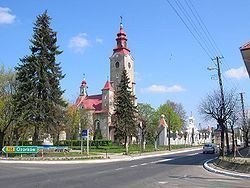Postal code 95-010 Area 8.15 km² Population 3,552 (2012) | Time zone CET (UTC+1) Car plates EZG Local time Wednesday 9:49 PM | |
 | ||
Weather 9°C, Wind W at 19 km/h, 86% Humidity | ||
Stryków [ˈstrɨkuf] (German: 1943-45 Strickau) is a town in central Poland, in Łódź Voivodeship, in Zgierz County. It has 3,552 inhabitants (2012).
Contents
Map of Stryk%C3%B3w, Poland
Early history
The first mention of Stryków was in 1387. Stryków was a village situated on the route from Zgierz to Lowicz. Stryków received city rights in 1394 from King Wladyslaw Jagiello, at the request of the heir of the town founder, Strykowskiego Deresława. In the middle of the eighteenth century, the city had 45 artisans (13 clothiers, 5 merchants and shopkeepers, and 5 others) and was a local center of commerce and crafts. It was also a center of aristocratic wealth.
In 1744 the town received the privilege of organizing eight fairs a year. Stryków belonged to medium-sized cities. Textile manufacturing was attempted by the then owner Felix Czarnecki but without success. The town economy remained centered on crafts and agriculture. Contemporary activities have left traces of the old town in the form of an existing semi-circular square in the city center.
After the Second Partition of Poland, Strykow was in the Prussian sector, and later in the period 1807-15 in the Duchy of Warsaw and then in the Russian-controlled Polish Kingdom. In the nineteenth century Stryków lost its civic rights. The reason for the stagnation of population growth was the rapid development of nearby Łódź and rapidly growing Pabianice and Zgierz.
Modern history
In 1902 Stryków was linked by rail to Warsaw and Łódź, which was followed by population growth. This rail link was closed for some years but was reopened in October 2011. Shortly after receiving civic independence in 1923, Strykow recovered as a town, with the economy based on shoemaking and tailoring.
In Stryków yarn and textiles were produced, and there was a brickyard. The town in 1939 had approximately 5,000 inhabitants. Hostilities, including the mass extermination of Polish Jews, the use of Poles for forced labor by the Nazis and those who left toward the end of the war of German ethnic origin (to the west with retreating German Army), led to a 45% reduction in the population. Northwest of the center of Stryków, are the remains of the Jewish cemetery, where the last burial took place in 1946.
In the post-war period, Stryków has become a dormitory community for the Łódź metropolis - many residents working in Łódź or in Zgierz and the new industrial estates alongside the A-1 (not yet completed but will run north to south) and A-2 highways. Stryków now has many great opportunities, being located at the intersection of these two major highways in Poland, A-1 and A-2.
